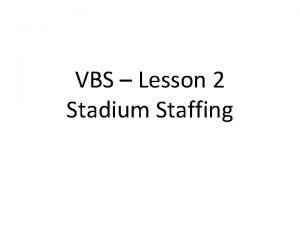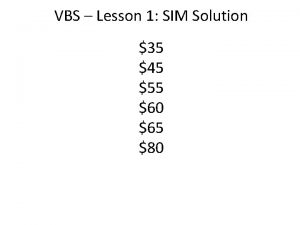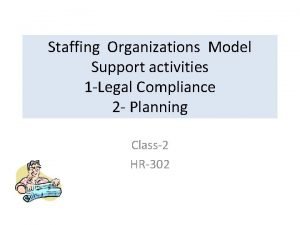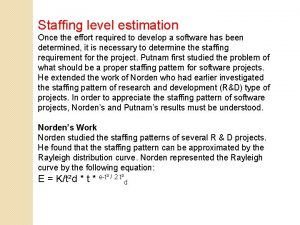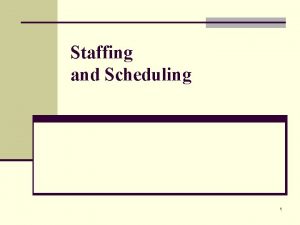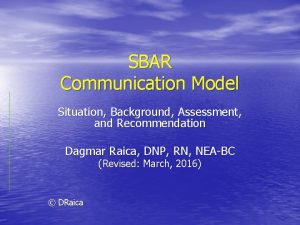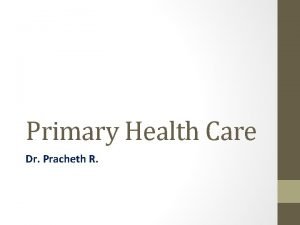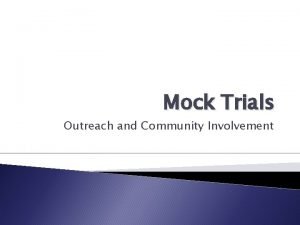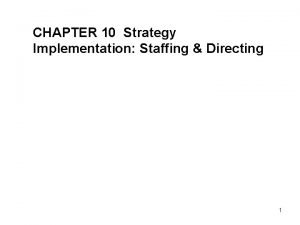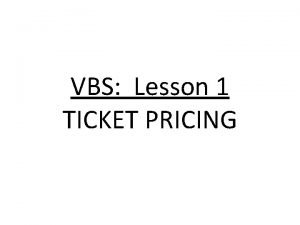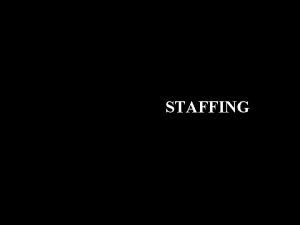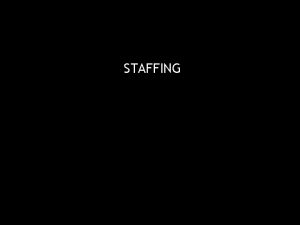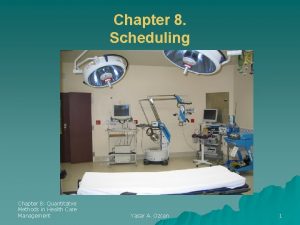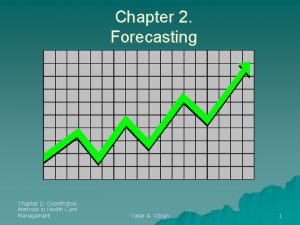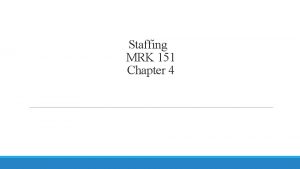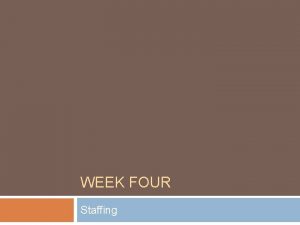Chapter 7 Staffing Chapter 7 Quantitatve Methods in









































- Slides: 41

Chapter 7. Staffing Chapter 7: Quantitatve Methods in Health Care Management Yasar A. Ozcan 1

Outline u u u Workload Management Overview The Establishment of Work Standards and Their Influence on Staffing Levels Patient Acuity Systems Internal Work Standards – Utilization of FTEs – FTEs for Nurse Staffing – Coverage Factor – Reallocation-Daily Adjustments External Work Standards Productivity & Workload Management Chapter 7: Quantitatve Methods in Health Care Management Yasar A. Ozcan 2

Importance of Staffing Decisions Human resources is the greatest expenditures of many health care organizations. In manufacturing, determination of skill-mix and staffing levels is fairly straight forward. In healthcare, uncertainty makes staffing particularly difficult. Chapter 7: Quantitatve Methods in Health Care Management Yasar A. Ozcan 3

What would you do? üStaff for peak levels at all times? üStaff for minimum census and acuity levels and hire part time agency nurses? What are problems with each approach? A solution-- flexible staffing! Chapter 7: Quantitatve Methods in Health Care Management Yasar A. Ozcan 4

Flexible Staffing Setting a core level staff based on a long term needs assessment which is then augmented by short-term (daily) adjustments using various methods to match staffing levels and patient needs. Chapter 7: Quantitatve Methods in Health Care Management Yasar A. Ozcan 5

Figure 7. 1 Workload Management Chapter 7: Quantitatve Methods in Health Care Management Yasar A. Ozcan 6

Workload Management: the components u u u Staffing-- determining the appropriate number of full-time equivalents (FTEs) to be hired in each skill class (RN, LPN, aides, MHA, MBA, etc. . ) Scheduling-- who is on and off duty and when; operational procedure Reallocation-- fine tunes the previous decisions; daily if not shift by shift Chapter 7: Quantitatve Methods in Health Care Management Yasar A. Ozcan 7

To staff efficiently we need a standard! u Work standard-- a predetermined allocation of time available for each unit of service (presumably at the appropriate quality level) – Acuity Adjusted-- patient days are adjusted for the acuity level of the patients being served u Example: Nursing hours per patient day – Procedural standard-- when the unit of service is a procedure, such as a lab test or x-ray u Example: Technicians per CT scan Chapter 7: Quantitatve Methods in Health Care Management Yasar A. Ozcan 8

Standard development Historically based solely on estimated average census of the entire organization What is a problem with this approach? 1) Doesn’t account for unit to unit variation. 2) Dependent upon a physician estimate of LOS. u Today, precise estimates of LOS can be determined from information systems. u Chapter 7: Quantitatve Methods in Health Care Management Yasar A. Ozcan 9

An adequate staffing system contains three components. Reliable patient classification and acuity system that determines patient need for services based on patient specific characteristics. u Development of time standards to reflect the time needed to provide services based on the patient classification system. u A method of converting total service time needed to FTEs u Chapter 7: Quantitatve Methods in Health Care Management Yasar A. Ozcan 10

The patient classification and acuity system Departmental acuity adjusted census is best for determining workload standards u Fewer staffing adjustments are necessary when an admissions monitoring information system is based on the unit’s patient care requirements rather than unit census. u An illustration: Who requires more care, a patient in the ICU or one recovering from minor surgery? u Chapter 7: Quantitatve Methods in Health Care Management Yasar A. Ozcan 11

Before developing acuity standards. . . A patient acuity system is necessary to measure the amount of care required by any given patient. u Also called patient classification systems u Chapter 7: Quantitatve Methods in Health Care Management Yasar A. Ozcan 12

Types of Acuity Systems u u Prototype systems – Classify according to type of care needed – Patients grouped into 3 -10 categories based on expected time commitments, diagnosis, mobility, and education needed – Highly subjective; easy to implement Factor-analytic systems – Establishes classes by summing relative values assigned to individual tasks or indicators of patient needs (Example: GRASP, MEDICUS) Chapter 7: Quantitatve Methods in Health Care Management Yasar A. Ozcan 13

Table 7. 2 Daily Census, Required Labor Hours, and Acuity Level Statistics for a Medical/Surgical Floor. If staffing was based on unadjusted census, inaccuracies would result. For instance, compare January 5 (Census = 9) and January 7 (Census =12). Which day would require a greater number of FTEs? Based on Patient Classification-Required Hours per Patient Day Census Date Day of Week AM PM Nigh t Total Number of Patients in Acuity Level 1 2 3 01/02/05 SUN 12 13 12 12. 3 1. 4 0. 8 4. 5 6 7 01/03//05 MON 13 12 12 12. 3 1. 9 1. 6 0. 9 4. 4 6 7 01/04/05 TUE 22 22 10 18. 0 2. 1 1. 7 1. 0 4. 7 5 16 01/05/05 WED 9 9. 0 2. 1 1. 7 1. 0 4. 8 2 7 01/06/05 THU 11 11 9 10. 3 1. 8 1. 4 0. 9 4. 1 3 3 5 01/07/05 FRI 12 12. 0 1. 6 1. 3 0. 7 3. 6 6 4 2 01/08/05 SAT 12 12 11 11. 7 2. 0 1. 6 0. 9 4. 6 3 3 4 Chapter 7: Quantitatve Methods in Health Care Management Yasar A. Ozcan 1 4 2 14

Table 7. 2 Daily Census, Required Labor Hours, and Acuity Level Statistics for a Medical/Surgical Floor. But, if we look at acuity levels, we observe that 80% of patients on January 5 are in categories 3 and 4, compared to only 17 percent in these categories on Jan. 7. The greater acuity is reflected in the greater number of required hours. Based on Patient Classification-Required Hours per Patient Day Census Date Number of Patients in Acuity Level Day of Week AM PM Night Total 1 2 3 01/02/05 SUN 12 13 12 12. 3 1. 4 0. 8 4. 5 6 7 01/03//05 MON 13 12 12 12. 3 1. 9 1. 6 0. 9 4. 4 6 7 01/04/05 TUE 22 22 10 18. 0 2. 1 1. 7 1. 0 4. 7 5 16 01/05/05 WED 9 9. 0 2. 1 1. 7 1. 0 4. 8 2 7 01/06/05 THU 11 11 9 10. 3 1. 8 1. 4 0. 9 4. 1 3 3 5 01/07/05 FRI 12 12. 0 1. 6 1. 3 0. 7 3. 6 6 4 2 01/08/05 SAT 12 12 11 11. 7 2. 0 1. 6 0. 9 4. 6 3 3 4 Chapter 7: Quantitatve Methods in Health Care Management Yasar A. Ozcan 1 4 2 15

Table 7. 3 Average Census, Required Labor Hours, and Acuity Level Statistics for a Medical/Surgical Floor. Average Census Year 200 3 Month AM P Based on Patient Classification-Avg. Required Hours per Patient Day Percent of Patients in Acuity Level Nigh t Total AM PM Nigh t Total 1 2 3 4 M January 14. 1 13. 8 13. 9 1. 8 1. 5 0. 9 4. 1 26. 3 26. 9 45. 0 1. 7 February 14. 9 14. 3 14. 1 14. 4 1. 8 1. 5 0. 9 4. 1 26. 2 31. 8 38. 6 3. 3 March 15. 3 14. 9 14. 6 14. 9 1. 5 0. 9 4. 3 19. 7 27. 5 48. 8 3. 5 April 18. 7 18. 4 18. 2 18. 4 1. 8 1. 4 0. 8 4. 1 27. 3 26. 4 44. 3 2. 0 May 19. 8 19. 5 19. 3 19. 5 2. 0 1. 6 0. 9 4. 4 21. 7 21. 0 52. 7 4. 3 June 19. 2 18. 5 18. 3 18. 7 1. 8 1. 5 0. 9 4. 2 23. 8 24. 9 50. 2 1. 1 Chapter 7: Quantitatve Methods in Health Care Management Yasar A. Ozcan 16

Table 7. 3 Average Census, Required Labor Hours, and Acuity Level Statistics for a Medical/Surgical Floor (Cont. ) July 8. 7 8. 2 7. 5 8. 1 1. 7 1. 4 0. 8 4. 0 18. 0 43. 4 38. 1 0. 6 August 8. 0 7. 5 6. 7 7. 4 1. 6 1. 4 0. 8 3. 7 23. 1 44. 8 32. 1 Septembe r 7. 4 6. 9 6. 5 6. 9 1. 8 1. 4 0. 8 4. 0 15. 4 44. 6 38. 2 October 6. 4 6. 1 5. 3 5. 9 1. 8 1. 5 0. 9 4. 1 13. 0 39. 7 47. 3 Novembe r 13. 5 13. 2 12. 7 13. 1 1. 8 1. 4 0. 8 4. 1 28. 7 30. 4 38. 3 2. 6 200 4 Decembe r 13. 3 12. 6 11. 2 12. 4 1. 6 1. 3 0. 7 30. 3 43. 6 25. 7 0. 4 200 5 January 11. 3 11. 2 10. 1 10. 9 1. 5 0. 9 4. 2 18. 9 32. 7 45. 9 2. 5 Mean 14. 4 13. 9 13. 4 14. 0 1. 8 1. 5 0. 8 4. 1 23. 3 32. 0 42. 1 2. 4 Minimum 4. 5 4. 4 4. 1 4. 3 1. 6 1. 3 0. 7 3. 7 12. 2 21. 0 25. 7 0. 0 Maximum 22. 8 22. 2 21. 9 22. 3 2. 0 1. 6 0. 9 4. 5 38. 0 44. 8 53. 7 5. 2 St. Deviation 5. 3 5. 1 5. 2 0. 1 0. 0 0. 2 6. 7 6. 8 1. 5 1. 7 Statistics Chapter 7: Quantitatve Methods in Health Care Management Yasar A. Ozcan 17

Standard Development u u Standards can be internal or external -- choice of standards used depends on cost and accuracy targets Internal standards are often more accurate – The first step in standard development is identifying and documenting the activities performed on the unit/department being examined – What tools might you use to identify these activities? Chapter 7: Quantitatve Methods in Health Care Management Yasar A. Ozcan 18

Fixed or Variable? u u All activities identified should be classified as fixed or variable – Fixed -- do not vary by volume – Variable -- fluctuate with services offered Classification by direct or indirect care should also be made – Direct -- centered around the patient – Indirect -- Patient care support services Can you think of examples of each? Chapter 7: Quantitatve Methods in Health Care Management Yasar A. Ozcan 19

Determining Activity Times Often no need to analyze all activities on the unit, but the activities chosen should be representative of all department activities u For some departments, it is better to analyze all activities, especially if service mix and complexity differs greatly What are some tools we can use to determine activity times? u Chapter 7: Quantitatve Methods in Health Care Management Yasar A. Ozcan 20

We should remember these! u u u Work sampling – often done by outside source Time and motion studies – expensive and time consuming; not common in healthcare Estimation- low cost and minimal time Historical averaging- easiest and least $$ Logging- excellent, low cost method Chapter 7: Quantitatve Methods in Health Care Management Yasar A. Ozcan 21

To determine work standards. . . Divide the total estimate of hours required for a given activity by the total volume to determine the workload standard. If Radiology works 1500 hours to produce 3000 x-rays, the work standard would be: 1500 hrs. = 30 minutes per x-ray 3000 x-rays Chapter 7: Quantitatve Methods in Health Care Management Yasar A. Ozcan 22

But can we expect 100% from anyone? Many factors prevent 100% staff utilization – Controllable-- staff scheduling, avoidable delays, scheduling of vacations, – Uncontrollable-- physician ordering patterns (and golf tournaments!), sick leave, market constraints of labor force u Estimating Utilization – Review historical levels and agree to a target – Quantify delays and downtime and allow for acceptable levels – Calculate a weighted average utilization Chapter 7: Quantitatve u Methods in Health Care Management Yasar A. Ozcan 23

Table 7. 4 Weighted Average Utilization for a Laboratory Based on Workload Fluctuations by Shift Percent of Work Load (A) Expected Utilization (Percent) (B) Weighted Utilization (A*B) Morning 45 95 . 428 Afternoon 35 85 . 298 Evening 7 90 . 063 Night 13 85 . 111 Total 100 0. 900 Weighted Average Utilization Target = 90 %. Chapter 7: Quantitatve Methods in Health Care Management Yasar A. Ozcan 24

Example 7. 1 A teaching hospital’s laboratory routinely performs nine microscopic procedures. Average monthly volume of each procedure has been determined from the historical data. An earlier time study also revealed the workload standard for each procedure, as shown in Table 7. 5 Workload Standards for Microscopic Procedures in Laboratory Variable Activities Volume (# of procedures per 30 -day period) Workload Standard (hours per procedure) Standard Hours for 30 -day period Procedure 1 350 . 12 42. 00 Procedure 2 222 . 30 66. 60 Procedure 3 185 . 45 83. 25 Procedure 4 462 . 26 120. 12 Procedure 5 33 . 84 27. 72 Procedure 6 12 . 88 10. 56 Procedure 7 96 . 362 34. 75 Procedure 8 892 . 46 410. 32 Procedure 9 26 1. 9 49. 4 TOTALS 2278 Chapter 7: Quantitatve Methods in Health Care Management 844. 72 Yasar A. Ozcan 25

Solution: The first step in setting staff levels for a procedure is to discover the number of procedures to be performed (A). By multiplying the volume for each procedure by the workload standard, a time estimate for each activity is made. The sum of the standard hours represents the total time needed to perform the procedures (B). Because this total represents only the direct procedure hours of the technicians, it must be augmented by the indirect (support) hours, which in this example are estimated at 0. 21 hours per procedure. Table 7. 4 depicts these calculations. Chapter 7: Quantitatve Methods in Health Care Management Yasar A. Ozcan 26

Table 7. 6 Calculation of Staffing Requirements for Microscopic Procedures Total volume of activities (tests) (A) 2278 Total direct procedure hours (B) 844. 72 Indirect support hours (C) =. 21 x (A) (assume 0. 21 hours per procedure) 478. 38 Subtotal variable hours required (D) = (B) + (C) 1323. 10 Department utilization target (E) [from above] 90. 00% Total variable hours required (normalized) (F) = (D)/(E) 1470. 11 Constant hours (G) (30 days at 12. 28 hours per calendar day in this example) 368. 40 Total target worked hours required (H) = (F) + (G) 1838. 51 Total target FTEs required (I) = (H) divided by 173. 33 (hours per FTE per month-(40 hrs. /wk. x 52 wks)/12 months) 10. 61 FTEs Vacation/holiday/sick FTE allowance (J) = (I) x 9. 8% (percentage varies by hospital department) 1. 04 FTEs Total Required Paid FTEs (K) = (I) + (J) 11. 65 FTEs Chapter 7: Quantitatve Methods in Health Care Management Yasar A. Ozcan 27

Determination of FTEs for Nurse Staffing. Determination of the FTEs required to staff a nursing unit requires several steps. First, the minutes of required care is determined using the following formula: Minutes of Care Required = (Average Census)*(Average Required Minutes per Patient) This equation then should be divided by the number of minutes available to work per nurse per day (equals 8 hours/day * 60 minutes/hour, or 480 minutes available) to determine the number of unadjusted FTEs. Thus, in second step, unadjusted FTEs are calculated using the next formula: Chapter 7: Quantitatve Methods in Health Care Management Yasar A. Ozcan 28

Determination of FTEs for Nurse Staffing. However, this method of calculation assumes 100 percent utilization of the staff, an assumption that is clearly unrealistic for the reasons mentioned earlier. Suppose that the administration has established a utilization standard of 0. 75; that is, 75 percent of each employee’s time will be spent in unproductive activities, or activities unrelated to direct patient care. The number of minutes available to work per nurse per day (example, 480 minutes) must be adjusted by the utilization standard; hence in the third step, core level FTEs is determined with this formula: Chapter 7: Quantitatve Methods in Health Care Management Yasar A. Ozcan 29

Example 7. 2: The nursing manger would like to determine the number of nursing staff needed for the medical/surgical unit. Table 7. 2 and Table 7. 3 provide census and acuity information for a medical/surgical floor. Solution: Table 7. 2 provides information on the daily census for January, 2005. Table 7. 3 aggregates the monthly data to provide the average census over a 25 -month period. Notice that the mean values presented in Table 7. 2, are the same as those found in the January, 2005 row in Table 7. 3. It is important to realize that the core staffing levels in this example are found through a retrospective analysis of average monthly census and required hours per patient day. Chapter 7: Quantitatve Methods in Health Care Management Yasar A. Ozcan 30

Table 7. 3 Average Census, Required Labor Hours, and Acuity Level Statistics for a Medical/Surgical Floor. Average Census AM PM Night Based on Patient Classification-Avg. Required Hours per Patient Day Total AM PM Night Total Percent of Patients in Acuity Level 1 2 Mean 14. 4 13. 9 13. 4 14. 0 1. 8 1. 5 0. 8 4. 1 23. 3 32. 0 42. 1 2. 4 Minimum 4. 5 4. 4 4. 1 4. 3 1. 6 1. 3 0. 7 3. 7 12. 2 21. 0 25. 7 0. 0 Maximum 22. 8 22. 2 21. 9 22. 3 2. 0 1. 6 0. 9 4. 5 38. 0 44. 8 53. 7 5. 2 Std. Deviation 5. 3 5. 1 5. 2 0. 1 0. 0 0. 2 6. 7 6. 8 1. 5 Chapter 7: Quantitatve Methods in Health Care Management Yasar A. Ozcan 3 4 31

Solution: The first step of the staffing calculation is to find the total number of minutes of care required, using formula: Minutes of Care Required = (Average Census)*(Average Required Minutes per Patient). Minutes of Care Required = (14 * 4. 1)*60 minutes = 3444 minutes. The second step uses next formula to divide the number of minutes available to work per nurse per day (480 minutes) to determine the number of unadjusted FTEs required. The third step determines the core level FTEs, using formula: Chapter 7: Quantitatve Methods in Health Care Management Yasar A. Ozcan 32

Determination of FTEs for Nurse Staffing. Coverage Factor. One other adjustment must be made to make sure that the core staffing levels are as accurate as possible. The above calculation assumes that employees will be available to work 365 days per year, without vacations, sick days, or holidays. To adjust for these factors, we must calculate a coverage factor. An example of the coverage factor adjustment is found in Table 7. 5. The first step in its determination is subtracting weekend days per year and benefit days from the required coverage days per year (365 in most any health care organization), to arrive at a total of available days per FTE (line 5). By dividing the total number of required days per year by the total available days, we obtain a coverage factor. This coverage factor is then multiplied by the unit FTE requirements to calculate the total unit FTE requirements. Chapter 7: Quantitatve Methods in Health Care Management Yasar A. Ozcan 33

Table 7. 7 The Effect of Shift Alternatives on Staffing – The Coverage Factor Assumptions 5/40 or 2/12 & 2/8 Plans 4/40 or 4/36 Plans (1) Required Coverage Days per Year 365 (2) Weekend Days per Year 104 156 (3) Benefit Days *Vacation *Sick Days *Holidays *Other 10 7 7 1 (4) Total Allowance Days of FTE (2) + (3) 129 181 (5) Total Available Days of FTE (1) - (4) 236 184 (6) Coverage Factor (1)÷(5) 1. 55 1. 98 Unit FTE Requirement Coverage Factor Total Unit FTE Requirements 5/40 9. 6 1. 55 15 4/40 9. 6 1. 98 19 4/36 9. 6 1. 98 19 2/12 & 2/8 9. 6 1. 55 15 Shift Alternatives Chapter 7: Quantitatve Methods in Health Care Management Yasar A. Ozcan 34

Figure 7. 2 Distribution of Daily Workload on a Nursing Unit Can the core level staff handle the unit’s activities? Chapter 7: Quantitatve Methods in Health Care Management Yasar A. Ozcan 35

External Work Standards u u u Two Types: – Industry Standards – Professional Standards Must be careful to adjust these factors for casemix and skill-mix Per se standards have been argued to lead to staffing standards that are inaccurate Chapter 7: Quantitatve Methods in Health Care Management Yasar A. Ozcan 36

Exhibit 7. 6 Factors to be Considered in Deciding on Staffing Levels üSize and design of facility üAverage length of stay üNon-nursing responsibilities üNursing responsibilities üIntensity/acuity levels of patients üReliability of patient classification system üClinical expertise of available staff üOrganized system of patient education üStaff mix üResearch and data management responsibilities üPatient transport responsibilities üPhysician practice patterns Chapter 7: Quantitatve Methods Health Care üin. Facility census patterns Management Yasar A. Ozcan 37

External Work Standards It is important to recognize that no standard is absolute. Some room must be left for flexibility in staffing. Figure 7. 3 demonstrates how statistical analysis can reveal whether the staff is meeting the standards. Figure 7. 3: Workload Standard Tolerance Ranges Chapter 7: Quantitatve Methods in Health Care Management Yasar A. Ozcan 38

Staffing and productivity Departmental productivity (the ratio of required hours to number of hours actually worked) is a measure of staff utilization Appropriateness of employee skills Matching of skills to job descriptions Worker satisfaction and work organization, retention, recruitment, and transfers also impact productivity Chapter 7: Quantitatve Methods in Health Care Management Yasar A. Ozcan 39

Staffing problems impacting productivity of workforce üWork load volume fluctuations--MD vacations impact ER staff productivity üWork load scheduling--should eliminate fluctuations as much as possible üSkill Mix--does it match work needs? üStaffing patterns-- can staff meet demand fluctuations? Chapter 7: Quantitatve Methods in Health Care Management Yasar A. Ozcan 40

The End Chapter 7: Quantitatve Methods in Health Care Management Yasar A. Ozcan 41
 Direct wax pattern
Direct wax pattern Stadium staffing math quiz answers
Stadium staffing math quiz answers Knowledge matters stadium staffing answers
Knowledge matters stadium staffing answers Align staffing
Align staffing The nature of staffing
The nature of staffing Planning organizing directing and controlling are the
Planning organizing directing and controlling are the Skilled staffing jean
Skilled staffing jean Staffing issues in strategy implementation
Staffing issues in strategy implementation It staffing strategy
It staffing strategy Digital staffing dashboard
Digital staffing dashboard Strategic staffing process
Strategic staffing process Staffing process
Staffing process Pertanyaan tentang staffing
Pertanyaan tentang staffing Staffing activities
Staffing activities Staffing level estimation
Staffing level estimation Awhonn staffing grid
Awhonn staffing grid Staffing pattern definition
Staffing pattern definition Staffing and scheduling
Staffing and scheduling Positioning and staffing the security function
Positioning and staffing the security function Sbar model communication
Sbar model communication Proposal venue
Proposal venue Staffing pattern of sub centre
Staffing pattern of sub centre Staffing adalah
Staffing adalah Sources of recruitment in hrm
Sources of recruitment in hrm The nature of staffing
The nature of staffing National research staffing mock jury
National research staffing mock jury Improving software economics set 1
Improving software economics set 1 Characteristics of ihrm
Characteristics of ihrm Hfd staffing member
Hfd staffing member Staffing pattern of phc
Staffing pattern of phc Fusion medical staffing llc
Fusion medical staffing llc Staffing organization model
Staffing organization model Staffing norms
Staffing norms Ingenuine definition
Ingenuine definition Nursing staffing calculation formula
Nursing staffing calculation formula Role of non-expatriates in ihrm
Role of non-expatriates in ihrm Staffing and directing.
Staffing and directing. Staffing follows strategy
Staffing follows strategy Usa staffing application
Usa staffing application 1ticket pricing
1ticket pricing Staffing definition
Staffing definition Strategic job analysis and competency modeling
Strategic job analysis and competency modeling

